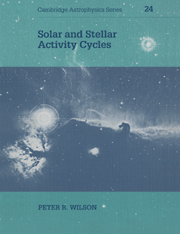Book contents
- Frontmatter
- Contents
- Preface
- Acknowledgments
- 1 Introduction
- 2 Historical survey
- 3 The structure of the Sun and the phenomena of activity
- 4 The equations of magnetohydrodynamics and magnetohydrostatics
- 5 The one-dimensional configuration of the cycle
- 6 Heuristic models of the solar activity cycle
- 7 Stellar activity and activity cycles
- 8 The two-dimensional representation of the extended activity cycle
- 9 The origin of the large-scale fields
- 10 The reversal of the polar magnetic fields
- 11 The role of dynamo theory in cyclic activity
- 12 Helioseismology and the solar cycle
- 13 Cyclic activity and chaos
- 14 Forecasting the solar cycle
- 15 Summary and conclusions
- Author index
- Subject index
10 - The reversal of the polar magnetic fields
Published online by Cambridge University Press: 27 October 2009
- Frontmatter
- Contents
- Preface
- Acknowledgments
- 1 Introduction
- 2 Historical survey
- 3 The structure of the Sun and the phenomena of activity
- 4 The equations of magnetohydrodynamics and magnetohydrostatics
- 5 The one-dimensional configuration of the cycle
- 6 Heuristic models of the solar activity cycle
- 7 Stellar activity and activity cycles
- 8 The two-dimensional representation of the extended activity cycle
- 9 The origin of the large-scale fields
- 10 The reversal of the polar magnetic fields
- 11 The role of dynamo theory in cyclic activity
- 12 Helioseismology and the solar cycle
- 13 Cyclic activity and chaos
- 14 Forecasting the solar cycle
- 15 Summary and conclusions
- Author index
- Subject index
Summary
The polar fields
The first observations of the Sun's weak polar magnetic fields were obtained in 1915 by Hale at Mount Wilson but, at that time, little attention was paid to their polarities in relation to those of sunspots. In 1957, however, Horace Babcock noted that, at the beginning of Cycle 19, the north polar fields were positive, as were the leader spots of the new cycle in the northern hemisphere. He further noticed that, as the cycle proceeded, the polar fields weakened and, in 1959, the mean magnetic polarity of the north polar field reversed, so that, for a period, the polarity of both polar fields was negative. Eighteen months later, the polarity of the south polar field also changed, so that, at the start of the next cycle (Cycle 20), the polar polarities in each hemisphere again corresponded to those of the leader spots. Similar reversals also occurred shortly after maximum during Cycles 20 and 21. On the basis of these three occurrences, it is now widely assumed that the global polar field of the Sun reverses with a period comparable to that of the sunspot magnetic cycle, but with a phase difference of ∼ 90°.
The polar fields are weak; even at sunspot minimum they are only a few gauss, and their reversals are not well defined. At times during the reversals, the polar regions are covered with weak patches of field of either polarity and the net polarity of the region is uncertain.
- Type
- Chapter
- Information
- Solar and Stellar Activity Cycles , pp. 173 - 190Publisher: Cambridge University PressPrint publication year: 1994

